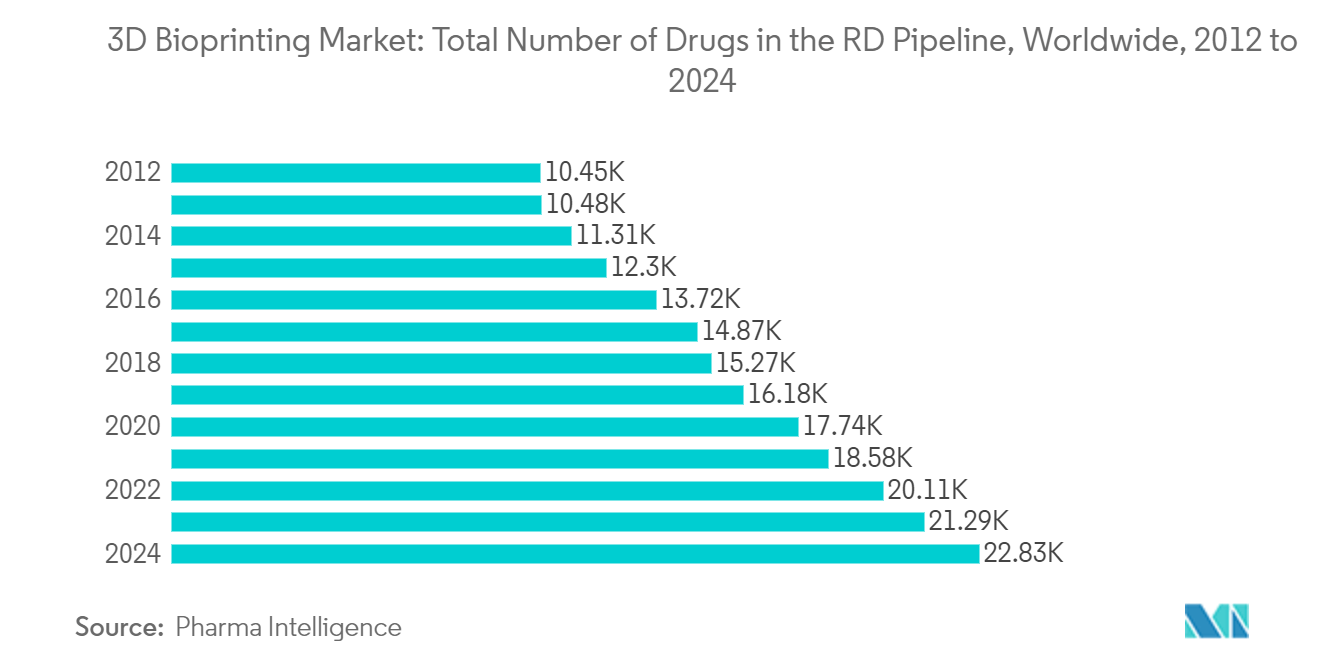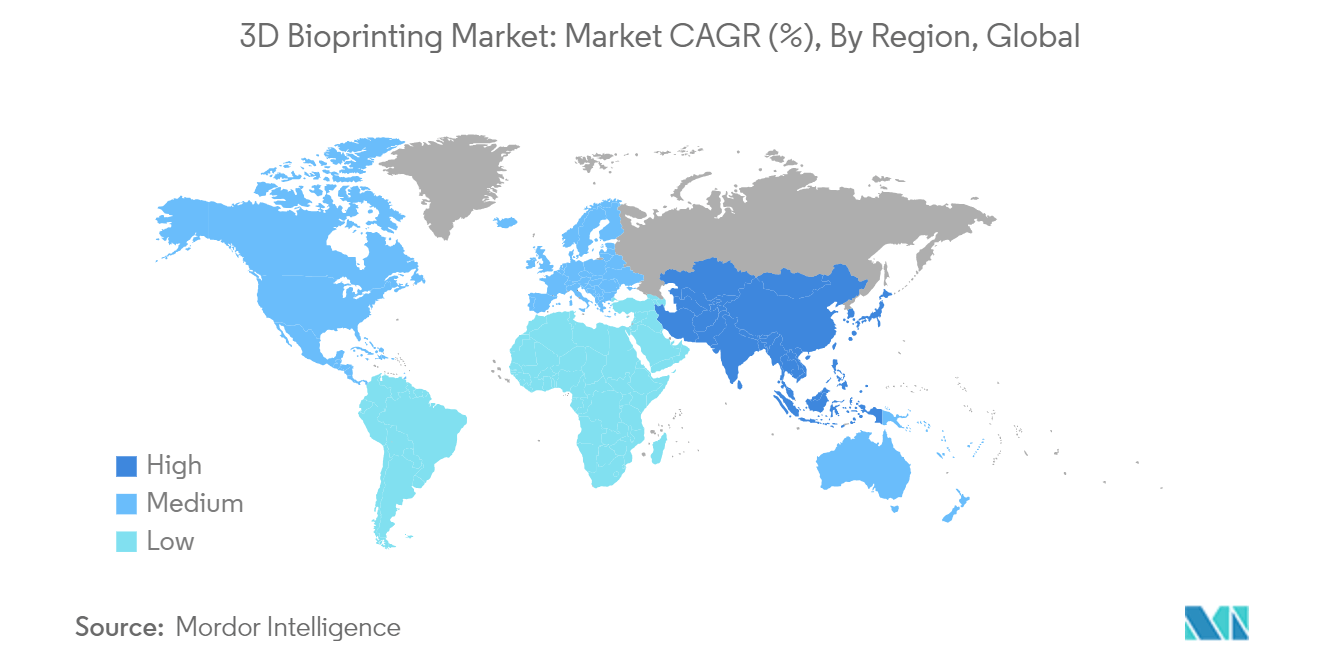Market Trends of 3D Bioprinting Industry
Drug Testing and Development Are Expected to Hold a Significant Market Share
- The field of drug testing and development greatly benefits from the implementation of 3D bioprinting technologies as they offer more precise and effective methods for pharmaceutical testing. Conventional drug testing models, such as animal testing and 2D cell cultures, have limitations in accurately predicting human reactions to new medications. On the other hand, 3D bioprinted tissues offer more realistic models that closely mimic actual organ systems and disease conditions, leading to faster and more dependable drug screening and development procedures.
- The remarkable advancement of 3D printing has paved the way for pharmaceutical applications, allowing for the creation of personalized drug screening and drug delivery systems tailored to each patient. This marks a departure from traditional methods that heavily depended on transgenic animal experiments and large-scale production. 3D printing enhances the effectiveness of current drug screening platforms by precisely placing biomaterials with patient-specific cells, thus replicating the natural conditions of the afflicted human body.
- The drug development process is an extensive, expensive, and demanding endeavor, but it is essential for introducing a new medication to the market. Typically, numerous compounds undergo multiple screening stages prior to clinical trials in the pursuit of drug discovery, and ultimately, only one compound receives approval. Traditionally, drug screening has heavily relied on transgenic animals as disease models. However, with the emergence of 3D bioprinting, new techniques are being developed to enhance the effectiveness of drug development.
- The market growth is expected to be supported by strict regulations imposed by government agencies, which require drug testing for safety reasons. Additionally, there is an increasing focus on monitoring and combating substance abuse, which further contributes to the market’s growth. The rising prevalence of substance abuse worldwide has led to higher demand for drug testing. The significant advancements in 3D printing technology have paved the way for pharmaceutical applications, allowing the creation of personalized drug screening and drug delivery systems for individual patients.
- For instance, in December 2023, FluidForm Bio, a US biotechnology company, made progress in 3D-printing human cardiac tissue using freeform reversible embedding of suspended hydrogels (FRESH) 3D bioprinting technology. By utilizing human induced pluripotent stem cell-derived cardiomyocytes (hiPSC-CMs), FluidForm managed to create an accurate model of human cardiac physiology for drug development purposes. This collaborative study involved scientists from FluidForm and Merck (MSD). Such significant developments in the field of 3D bioprinting for drug development applications will drive the market's growth.
- Pharmaceutical companies are using bioprinted tissues for drug testing, enabling them to swiftly identify promising candidates and eliminate ineffective or hazardous ones at an early stage of development. This enhanced efficiency can lead to substantial cost savings in research and development, as well as expedite the availability of innovative therapies. The rising prevalence of chronic diseases and the increasing demand for safe medications within the medical sector will further fuel the market's growth. Additionally, the emergence of 3D bioprinting allows drug developers to address the challenges associated with human clinical trials by promptly identifying potential complications. These advantages are expected to further bolster the market's expansion in drug development applications.

Asia-Pacific is Expected to Witness Significant Growth
- Asia-Pacific is the fastest-growing market for 3D bioprinting, mainly due to a strong existing consumer base, the massive scope of 3D printing in medical services, increasing R&D for 3D printing, and government support and tax incentives. The adoption of 3D printing in China is rapidly picking pace compared to other developed economies, such as North America and Europe, though it was not among the earliest adopters of the technology. The primary factor driving this growth is the support from the Chinese government in the innovation, development, and adoption of the technology across several end-user industries in the country.
- The country also witnessed various kinds of research in bio-manufacturing. Tsinghua University (Beijing, China) is one of the leading laboratories in the interdisciplinary field of additive manufacturing and 3D bioprinting. Sponsored by the Ministry of Science and Technology of China, the National Natural Science Foundation of China, the National Health Commission of China, and the Beijing Municipal Science & Technology Commission, its bio-manufacturing center is highly dedicated to conducting research involving biomaterials, living cells, proteins, and other biological compounds, as basic building blocks to fabricate biomimetic structures. This research finds applications in various areas, such as tissue engineering, regenerative medicine, disease pathogenesis, drug screening, and tissue/organ-on-a-chip.
- Chinese scientists have made significant progress in the field of 3D bioprinting, particularly with the liquid-in-liquid printing method. By utilizing liquid polymers, they have developed a technique that forms a durable membrane when the liquids come into contact. These liquid structures have the remarkable ability to maintain their shape for up to 10 days before eventually merging. This innovative approach enables the printing of intricate shapes and opens up possibilities for creating complex 3D-printed tissues using living cells.
- In India, the concept of 3D bioprinting is gradually gaining traction, with a focus on academic and research labs such as the Indian Institute of Science (IISc), Indian Institutes of Technology (IITs), National Institutes of Technology (NITs), Sree Chitra Tirunal Institute for Medical Sciences and Technology (SCTIMST), and other universities. The collaboration between CELLINK, a prominent player in the development of 3D bioprinters, and IISc further propelled the advancement of 3D bioprinting technology. This partnership led to the establishment of a Centre of Excellence (CoE) for 3D bioprinting in Bengaluru, providing a significant boost to the market.
- According to the Indian Brand Equity Foundation, the healthcare sector is one of the fastest-growing in the country. In the recent budget, India's public expenditure on healthcare stood at 1.2% as a percentage of the GDP. The Government of India plans to increase public health spending to 2.5% of the GDP by 2025. Such trends in the healthcare sector are expected to boost the country's market growth significantly.
- Many Indian start-ups are making bioprinting technology popular through innovative solutions. For instance, Biop, established by BITS Pilani and Goa students, aims to change medical research by manufacturing the equipment and technology for 3D bioprinting. The product can form human tissues with one click, using sensors, actuators, and UV technology to control the 3D bioprinting. The company collaborated with MIT and Harvard. The growth of start-ups, as well as the increasing elderly population and cancer cases, is among the significant factors set to fuel the market's growth over the forecast period.
- Pandorum Technologies reported that since India revised its New Drugs and Clinical Trial Rules in March 2023, researchers can employ alternative methods for assessing the safety and efficacy of new medications. This amendment has the potential to greatly enhance the development of 3D bioprinting, a field that has seen significant growth in India in recent years. According to the company, as of January 2024, the 2023 amendment permitted the utilization of 3D bioprinted tissues as a substitute for various laborious preclinical or animal studies. Contract research organizations have already conducted preclinical drug tests on 3D bioprinted corneas.
- The Japanese government estimates that the regenerative medicine industry will record a revenue of JPY 1 trillion by 2030. The New Energy and Industrial Technology Development Organization (NEDO) expects that emerging and innovative technologies, such as 3D bioprinting, may lead the market in the near future.


